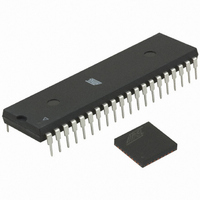ATMEGA64RZAV-10PU Atmel, ATMEGA64RZAV-10PU Datasheet - Page 60

ATMEGA64RZAV-10PU
Manufacturer Part Number
ATMEGA64RZAV-10PU
Description
MCU ATMEGA644/AT86RF230 40-DIP
Manufacturer
Atmel
Series
ATMEGAr
Datasheets
1.ATMEGA644-20MU.pdf
(23 pages)
2.ATMEGA644-20MU.pdf
(376 pages)
3.AT86RF230-ZU.pdf
(98 pages)
Specifications of ATMEGA64RZAV-10PU
Frequency
2.4GHz
Modulation Or Protocol
802.15.4 Zigbee
Power - Output
3dBm
Sensitivity
-101dBm
Voltage - Supply
1.8 V ~ 3.6 V
Data Interface
PCB, Surface Mount
Memory Size
64kB Flash, 2kB EEPROM, 4kB RAM
Antenna Connector
PCB, Surface Mount
Package / Case
40-DIP (0.600", 15.24mm)
Wireless Frequency
2.4 GHz
Interface Type
JTAG, SPI
Output Power
3 dBm
For Use With
ATSTK600-TQFP32 - STK600 SOCKET/ADAPTER 32-TQFPATAVRISP2 - PROGRAMMER AVR IN SYSTEMATSTK500 - PROGRAMMER AVR STARTER KIT
Lead Free Status / RoHS Status
Lead free / RoHS Compliant
Operating Temperature
-
Applications
-
Data Rate - Maximum
-
Current - Transmitting
-
Current - Receiving
-
Lead Free Status / Rohs Status
Lead free / RoHS Compliant
For Use With/related Products
ATmega64
- Current page: 60 of 376
- Download datasheet (8Mb)
11. External Interrupts
11.1
11.1.1
60
Register Description
ATmega644
EICRA – External Interrupt Control Register A
The External Interrupts are triggered by the INT2:0 pin or any of the PCINT31:0 pins. Observe
that, if enabled, the interrupts will trigger even if the INT2:0 or PCINT31:0 pins are configured as
outputs. This feature provides a way of generating a software interrupt.
The Pin change interrupt PCI3 will trigger if any enabled PCINT31:24 pin toggle, Pin change
interrupt PCI2 will trigger if any enabled PCINT23:16 pin toggles, Pin change interrupt PCI1 if
any enabled PCINT15:8 toggles and Pin change interrupts PCI0 will trigger if any enabled
PCINT7:0 pin toggles. PCMSK3, PCMSK2, PCMSK1 and PCMSK0 Registers control which pins
contribute to the pin change interrupts. Pin change interrupts on PCINT31:0 are detected asyn-
chronously. This implies that these interrupts can be used for waking the part also from sleep
modes other than Idle mode.
The External Interrupts can be triggered by a falling or rising edge or a low level. This is set up
as indicated in the specification for the External Interrupt Control Registers – EICRA (INT2:0).
When the external interrupt is enabled and is configured as level triggered, the interrupt will trig-
ger as long as the pin is held low. Low level interrupts and the edge interrupt on INT2:0 are
detected asynchronously. This implies that these interrupts can be used for waking the part also
from sleep modes other than Idle mode. The I/O clock is halted in all sleep modes except Idle
mode.
Note that if a level triggered interrupt is used for wake-up from Power-down, the required level
must be held long enough for the MCU to complete the wake-up to trigger the level interrupt. If
the level disappears before the end of the Start-up Time, the MCU will still wake up, but no inter-
rupt will be generated. The start-up time is defined by the SUT and CKSEL Fuses as described
in
The External Interrupt Control Register A contains control bits for interrupt sense control.
• Bits 7:6 – Reserved
These bits are reserved in the ATmega644, and will always read as zero.
• Bits 5:0 – ISC21, ISC20 – ISC00, ISC00: External Interrupt 2 - 0 Sense Control Bits
The External Interrupts 2 - 0 are activated by the external pins INT2:0 if the SREG I-flag and the
corresponding interrupt mask in the EIMSK is set. The level and edges on the external pins that
activate the interrupts are defined in
nously. Pulses on INT2:0 pins wider than the minimum pulse width given in
generate an interrupt. Shorter pulses are not guaranteed to generate an interrupt. If low level
interrupt is selected, the low level must be held until the completion of the currently executing
instruction to generate an interrupt. If enabled, a level triggered interrupt will generate an inter-
rupt request as long as the pin is held low. When changing the ISCn bit, an interrupt can occur.
Therefore, it is recommended to first disable INTn by clearing its Interrupt Enable bit in the
EIMSK Register. Then, the ISCn bit can be changed. Finally, the INTn interrupt flag should be
Bit
(0x69)
Read/Write
Initial Value
”System Clock and Clock Options” on page
R
7
–
0
R
6
–
0
ISC21
R/W
5
0
Table
ISC20
R/W
11-1. Edges on INT2:INT0 are registered asynchro-
4
0
27.
ISC11
R/W
3
0
ISC10
R/W
2
0
ISC01
R/W
1
0
ISC00
R/W
Table 11-2
0
0
2593N–AVR–07/10
EICRA
will
Related parts for ATMEGA64RZAV-10PU
Image
Part Number
Description
Manufacturer
Datasheet
Request
R

Part Number:
Description:
DEV KIT FOR AVR/AVR32
Manufacturer:
Atmel
Datasheet:

Part Number:
Description:
INTERVAL AND WIPE/WASH WIPER CONTROL IC WITH DELAY
Manufacturer:
ATMEL Corporation
Datasheet:

Part Number:
Description:
Low-Voltage Voice-Switched IC for Hands-Free Operation
Manufacturer:
ATMEL Corporation
Datasheet:

Part Number:
Description:
MONOLITHIC INTEGRATED FEATUREPHONE CIRCUIT
Manufacturer:
ATMEL Corporation
Datasheet:

Part Number:
Description:
AM-FM Receiver IC U4255BM-M
Manufacturer:
ATMEL Corporation
Datasheet:

Part Number:
Description:
Monolithic Integrated Feature Phone Circuit
Manufacturer:
ATMEL Corporation
Datasheet:

Part Number:
Description:
Multistandard Video-IF and Quasi Parallel Sound Processing
Manufacturer:
ATMEL Corporation
Datasheet:

Part Number:
Description:
High-performance EE PLD
Manufacturer:
ATMEL Corporation
Datasheet:

Part Number:
Description:
8-bit Flash Microcontroller
Manufacturer:
ATMEL Corporation
Datasheet:

Part Number:
Description:
2-Wire Serial EEPROM
Manufacturer:
ATMEL Corporation
Datasheet:










